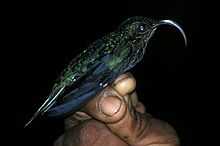White-tipped Sicklebill
From Wikipedia, the free encyclopedia
| White-tipped Sicklebill | |
|---|---|
 | |
| From Cordillera del Cóndor, Ecuador. | |
| Conservation status | |
| Scientific classification | |
| Kingdom: | Animalia |
| Phylum: | Chordata |
| Class: | Aves |
| Order: | Apodiformes |
| Family: | Trochilidae |
| Genus: | Eutoxeres |
| Species: | E. aquila |
| Binomial name | |
| Eutoxeres aquila Bourcier, 1847 | |
The White-tipped Sicklebill (Eutoxeres aquila) is a species of hummingbird in the Trochilidae family. It is found in Costa Rica and Panama of Central America, and Colombia, Ecuador, and far northern Peru. There is also a single recent record from Mérida in Venezuela.
Its natural habitat is the undergrowth of subtropical or tropical humid lowland or montane forest. Its curved bill helps it reach nectar deep in its favorite flower.
References
- ↑ BirdLife International (2012). "Eutoxeres aquila". IUCN Red List of Threatened Species. Version 2013.2. International Union for Conservation of Nature. Retrieved 26 November 2013.
| Wikimedia Commons has media related to Eutoxeres aquila. |
External links
- White-tipped Sicklebill photo; Article AOCR
- Article w/RangeMaps, Eutoxeres aquila InfoNatura NatureServe
| ||||||||||||||||||||||||||||
This article is issued from Wikipedia. The text is available under the Creative Commons Attribution/Share Alike; additional terms may apply for the media files.
